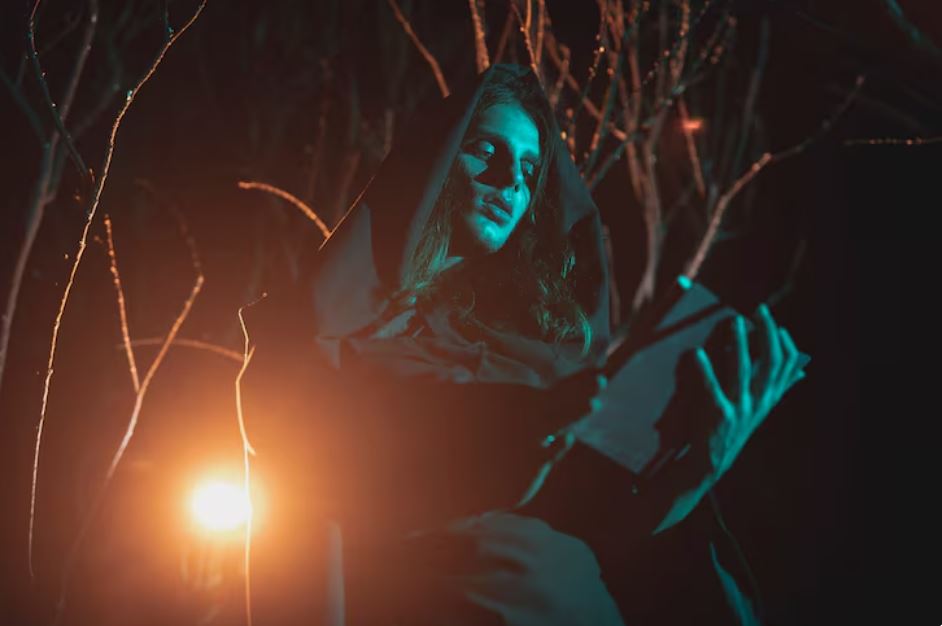
Science can feel haunted by its own discoveries at times, and the haunted frequencies story aptly reflects that feeling. Unease started to permeate the atmosphere in the 1980s while engineer Vic Tandy was working late in his Coventry laboratory. The silence was heavy, and the shadows seemed alive. Then, in a single moment that would go down in physicists’ and ghost hunters‘ legends, he noticed a gray mist forming next to him, eerily still and vaguely human in shape. It was gone in an instant, only the thud of his heart remaining.
By morning, curiosity triumphed over fear. Tandy noticed an oddity while calibrating his apparatus: a piece of fencing foil that he kept clamped to a bench was vibrating by itself. No breeze, no footsteps, only a steady shudder. He would later learn that the source was a new fan that had been installed in the lab. It was creating a faint hum at 18.98 Hz, which is below human hearing but exactly at the resonance of the human eye. It was a frequency capable of distorting perception, causing the air to tremble, the shadows to dance, and the mind to conjure up ghosts.
| Category | Details |
|---|---|
| Phenomenon | Haunted Frequencies – the occurrence of ghostly sensations or visions triggered by inaudible low-frequency sound waves (infrasound). |
| Frequency Range | Below 20 Hz – vibrations too low for human ears to detect but powerful enough to affect the body and mind. |
| Key Researcher | Vic Tandy, British engineer who identified the “Ghost Frequency” (18.98 Hz) in the 1980s. |
| Notable Incident | Coventry Laboratory, England – where a new ventilation fan produced the infrasound that created a ghostly illusion. |
| Documented Effects | Feelings of fear, nausea, anxiety, chills, and visual disturbances caused by eye resonance. |
| Modern Implications | Used intentionally in horror films, sound design, and immersive attractions to trigger unease. |
| Natural Sources | Storms, earthquakes, ocean waves, volcanic activity, and animal communication. |
| Human-Made Sources | Engines, wind turbines, industrial fans, and subwoofers. |
| Scientific Interpretation | Infrasound creates resonance in human organs and optical nerves, leading to sensory confusion mistaken for supernatural presence. |
Because Tandy’s discovery linked a haunting to physics rather than folklore, it was especially groundbreaking. His body, particularly the fluid and tissue of his eyes, was reacting to the fan’s vibrations, creating slight visual distortions that resembled spectral shapes. What we commonly refer to as “haunted” may occasionally simply be “out of tune,” according to his findings, which were later published in a scientific journal.
Since then, researchers from a variety of fields have been captivated by infrasound, the unseen cause of many of these sensations. It travels through both air and structures like an invisible current and is defined as sound below 20 hertz. Although humans are unable to hear it consciously, our bodies unquestionably respond to it. These low waves vibrating through our organs cause physiological reactions, not imagined feelings of dread, nausea, or uneasiness. It serves as a reminder that sound itself has the power to literally create fear.
Scientists have conducted controlled replications of Tandy’s experience over the years. Many participants reported experiencing cold shivers, lightheadedness, or the uncanny feeling of being watched when exposed to infrasound in a lab setting. The findings remarkably resembled descriptions from centuries of ghost stories. Researchers at the National Physical Laboratory in London verified in one particularly noteworthy study that exposure close to the “haunted frequency” caused anxiety in people, even when they were unaware that a sound was being played.
Artists and filmmakers have been influenced by this hidden aspect of sound, in addition to scientists. In order to arouse discomfort, sound designers purposefully incorporate these tones into their scores for horror films. The vibrating drone in The Conjuring or the low hum that permeates the conversation in Paranormal Activity are examples of biological manipulation rather than merely artistic expression. These hardly noticeable frequencies appeal to our innate survival and danger instincts, making the audience tense even when they are silent. The method has been incredibly successful in influencing the sensory language of contemporary horror.
The entertainment industry was able to replicate fear without displaying any ghosts by utilizing this scientific discovery. These days, sub-bass speakers tuned below hearing range are used in virtual reality experiences, haunted houses, and even theme park rides. Something invisible is moving close by, and the air trembles just enough to give you the impression that something is amiss. The body is aware of the subtle effect.
The way that haunted frequencies conflate science and spirituality is especially intriguing. They show that what people perceive as paranormal sensations might actually be the body reacting to resonance. However, this knowledge does not take away from the experience’s emotional impact. People continue to talk about an inexplicable sensation—a sense of presence, as though there were energy still present in the space. The mystery may remain sacred despite explanation because it serves as a reminder of our own susceptibility to the invisible.
The infrasound case also suggests how our surroundings shape our beliefs. For instance, the tall arches and lengthy passageways found in many old cathedrals were built to naturally amplify these low frequencies. Congregations may experience awe and even tears as a result of the vibration during hymns or organ performances. Architectural acoustics—resonating bodies, trembling souls, and hearts attuned to invisible vibration—may have contributed to what previous generations referred to as divine presence.
Unintentionally, modern technology still encounters haunted frequencies. Researchers keeping an eye on earthquakes, engineers testing jet engines, and even marine biologists researching whale communication have all reported odd psychological effects following extended exposure to infrasound. The fact that animals, such as pigeons and elephants, appear to be inherently sensitive to these frequencies and can identify storms or tremors before people do is especially fascinating. It appears that nature has long recognized the eerie potential of sound.
Curiously, modern music has also been impacted by haunted frequencies. Ultra-low basslines are used by some electronic producers to simulate a tense or transcendental atmosphere. Even though they might not be aware of it, listeners sense the tone—deep in their chest, subtly emotional. These frequencies have been used by artists such as Aphex Twin and Ben Frost to simulate spirituality, anxiety, or the immensity of space. Once more, the line between artistic expression and scientific advancement blurs beautifully.
Despite their fascination, haunted frequencies teach us something very human. They serve as a reminder that our senses are sensitive organs that can perceive extraordinary things but are also susceptible to deception. We can develop empathy as well as insight by comprehending how sound influences emotion. While acknowledging the remarkable complexity of what it means to feel haunted, it teaches us to challenge fear.
More in-depth research on infrasound is anticipated in the upcoming years by both sound engineers and researchers, for both safety and innovative purposes. For example, incorporating acoustic analytics into urban planning could greatly lessen the anxiety that low-frequency noise pollution causes. On the other hand, music therapists can use these frequencies in precisely calibrated ways to create meditative, grounding spaces that help people decompress.
This transition from superstition to science, from fear to understanding, has a poetic quality. Haunted frequencies started out as unintentionally recorded ghost stories but have since developed into a monument to human curiosity. What used to frighten us now teaches us. What used to make us shudder in fear now makes us awe at how perfectly balanced our bodies are.
